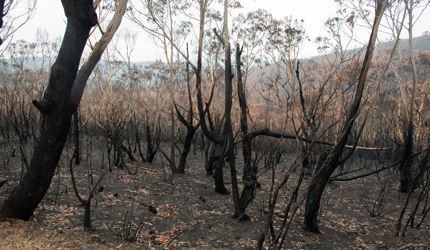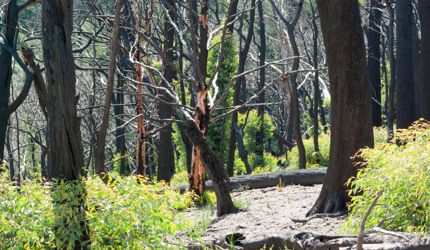
Changes to the quality of runoff
Past bushfires have resulted in significant water quality emergencies, for example:
- contamination of water supply reservoirs in Canberra’s Cotter catchment, leading to disruptions to water supply and the need to construct a new water treatment plant (White I. et al, 2006)
- a significant fish kill due to near-zero dissolved oxygen levels in the Ovens River in north-east Victoria following a severe storm over a fire-impacted tributary (Smith, H. et al., 2011)
Numerous studies following past bushfires have given us a trove of data with which to predict future impacts on the quality of runoff (e.g. Sheridan, G.J. et al. 2007). The short term increase in runoff rates following bushfires exacerbates the risks of water quality emergencies following bushfires.

Changes to the quantity of runoff
Bushfires in Australian eucalypt forests lead to significant detrimental impacts on runoff volumes, and the quality of runoff. Numerous studies (Langford, K. J. 1976; Kuczera, G. A. 1985; Hill, P. I. et al. 2008) have found that for a given rain event, runoff volumes initially increase compared with pre-bush fire rates, then significantly reduce before returning to pre-fire rates as the regrowth forest matures. This behaviour is shown below:

The initial responses of runoff rates to bushfire can be even more complex. Fire can make the soil hydrophobic, leading to increased rates of runoff, fire can open up cracks or root holes, leading to increased infiltration and reduced runoff rates, or ash can seal soil pores, leading to increased runoff (Sheridan, G.J. et al. 2007).
Destruction of the forest and canopy, and death of the trees, is the major driver of the short-term change in runoff rates, as the trees can no longer transpire, and the canopies no longer intercept rainfall. As the trees regrow and mature the leaf area of the canopies increase, and root zone becomes deeper. The increasing leaf area leads to higher transpiration rates and so reducing runoff, and the deeper root zone enables the growing forest to access water from deeper in the soil profile, also contributing to reducing runoff as the trees regrow.



